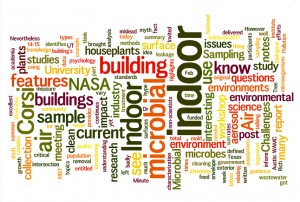Glad to see this paper on emission of bacteria by people is now available under Wiley’s “Open Access” option: Size-resolved emission rates of airborne bacteria and fungi in an occupied classroom – Qian – 2012 I am particularly glad since this one got a lot of media coverage and I think it is VERY important for …
Well, this week the target of the “how many microbes are there on ….?” question from the press is your computer and it’s mice: How Your Office Computer Mouse Carries Three Times More Germs Than A Toilet Seat | Leadership Newspapers. The obsession in the press with “how many microbes can you find on something” continues …
Looking for input on a couple of new pages on the microBEnet site. The first is a revised, updated list of all the grantees in the Sloan Foundation’s microbiology of the built environment program. This might be useful for anyone considering the recent call for proposals. If you’re a Sloan Grantee, we’d really appreciate it …
I really love Wordle and Tag Clouds. Here is one for the microBEnet blog. For the original version at Wordle see here.
We’ve talked here in the past about the idea of probiotics for buildings (which is many years in the future, if ever) and pretty much everyone has heard about probiotics for human health (currently an issue of much debate). One of the problems with both buildings and people is the difficulty of testing a hypothesis …
This study came out online in February and provided a very interesting look into the role of human occupancy in relation to indoor biological aerosols. Most strikingly the authors found that millions of bacteria and fungi are added to the air in an occupied room, mostly through stirring up previously deposited organisms. Yesterday an article …
Another new grant in the microbiology of the built environment program, by Rob Knight at CU Boulder, in collaboration with Robert Van Pelt: Title: “Microbially Visible Home” “The Microbially Visible Home will perform dense spatial and temporal sampling of the ArcheType sustainable house in Toronto, linking microbial data to BIM (Building Information Models) in order …
James Scott, from U. Toronto and Sporometrics was kind enough to share a paper version of the keynote talk he gave recently at the IAQA meeting in Las Vegas. Entitled “An Evolving Architecture” it covers a lot of topics related to indoor microbiology and the use of molecular methods to study microbes. Here is a …
An official missive from the Sloan Foundation (PDF version here) Dear Colleague − The Alfred P. Sloan Foundation has created a new funding opportunity in its Microbiology of the Built Environment program. The Foundation seeks to support up to four new studies of the microbiology of the built environment. Successful projects will be either hypothesis …
A new paper is out supported in part by the Alfred P. Sloan Foundation’s “microbiology of the Built Environment program” — Nuclear ribosomal internal transcribed spacer ITS region as a universal DNA barcode marker for Fungi. It is available for free to all via the PNAS “Open Option”. The paper discussing work assessing the potential for …
